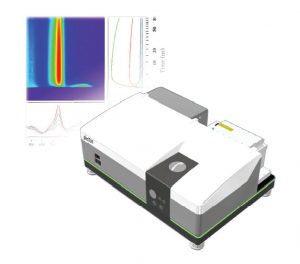picoTAS
TRANSIENT ABSORPTION SPECTROMETER with pico second resolution
APPLICATIONS
Observation of Transient Absorption Spectra of Excited Singlet/Triplet State
Measurement of Intersystem Crossing (ISC) Rate
Research of Electron Transfer, Charge Separation/Recombination Dynamics
Observation of Intermolecular Reaction, Excimer Generation etc.
Dynamics of Artificial Photosynthesis, Solar Energy Cell, Organic EL
Photon stimulated reactions
Organic Solar Cell,
Organic and molecular electronics
Quantum-Dot
Fluorochrome-Labeled DNA
What is TAS?
Transient Absorption Spectroscopy (TAS) is a high-speed time resolved absorption measurement. A pulsed light (pump light) excites the target material. The subsequent processes are observed by time resolved spectroscopic analysis. In contrast to fluorescence spectroscopy, TAS can explore non-fluorescent reactions over a wide time regime such as short-lived radical species, intermediate and charge transfer states.
Why use picoTAS?
picoTAS has some distinct advantages over conventional transient absorption techniques. Other than the “Pump & Probe” method or the “Nanosecond Flash Photolysis” method, picoTAS can measure from the pico second regime to milli seconds. And it can detect fluorescent and non-fluorescent intermediates.
picoTAS has an ingenious way to remove overlaying luminescence signal and can obtain an accurate transient absorption (TA) signal of i.e. excited singlet and triplet states.
SPECIFICATIONS
| Models | picoTAS-ns | picoTAS-ps | ||||||||||||||||
|---|---|---|---|---|---|---|---|---|---|---|---|---|---|---|---|---|---|---|
| Method | RIPT method (Randomly Interleaved Pulse Train method) | |||||||||||||||||
| Time Resolution (10%–90% rise time) | <400 ps | <100 ps | ||||||||||||||||
| Delay Time resolution | 10 ps, 20 ps, 50 ps, 100 ps, 200 ps, 500 ps, 1 ns, 2 ns, 5 ns, 10 ns, 20 ns | |||||||||||||||||
| Full scale | 100 ns–2 ms | |||||||||||||||||
| Wavelength Range | 410–1600 nm | |||||||||||||||||
| Automatic Control | wavelength scan, light intensity adjustment, shutter control | |||||||||||||||||
| Sample Holder | solution (optical path length is 2 mm), thin film | |||||||||||||||||
| Pump Light Source |
|
|||||||||||||||||
| Probe Light Source |
|
|||||||||||||||||
| PC & Software |
|
|||||||||||||||||
| Installation Requirement | optical bench not required | optical bench required | ||||||||||||||||

